Kimchi Jjigae is a spicy Korean stew of pork belly, tofu, and Korean fermented napa cabbage simmered in a delicate anchovy broth. My simple version is full of sweet, salty, sour, and spicy flavors. Popular in Japan, Kimchi Jjigae will warm you up and keep the chill at bay.
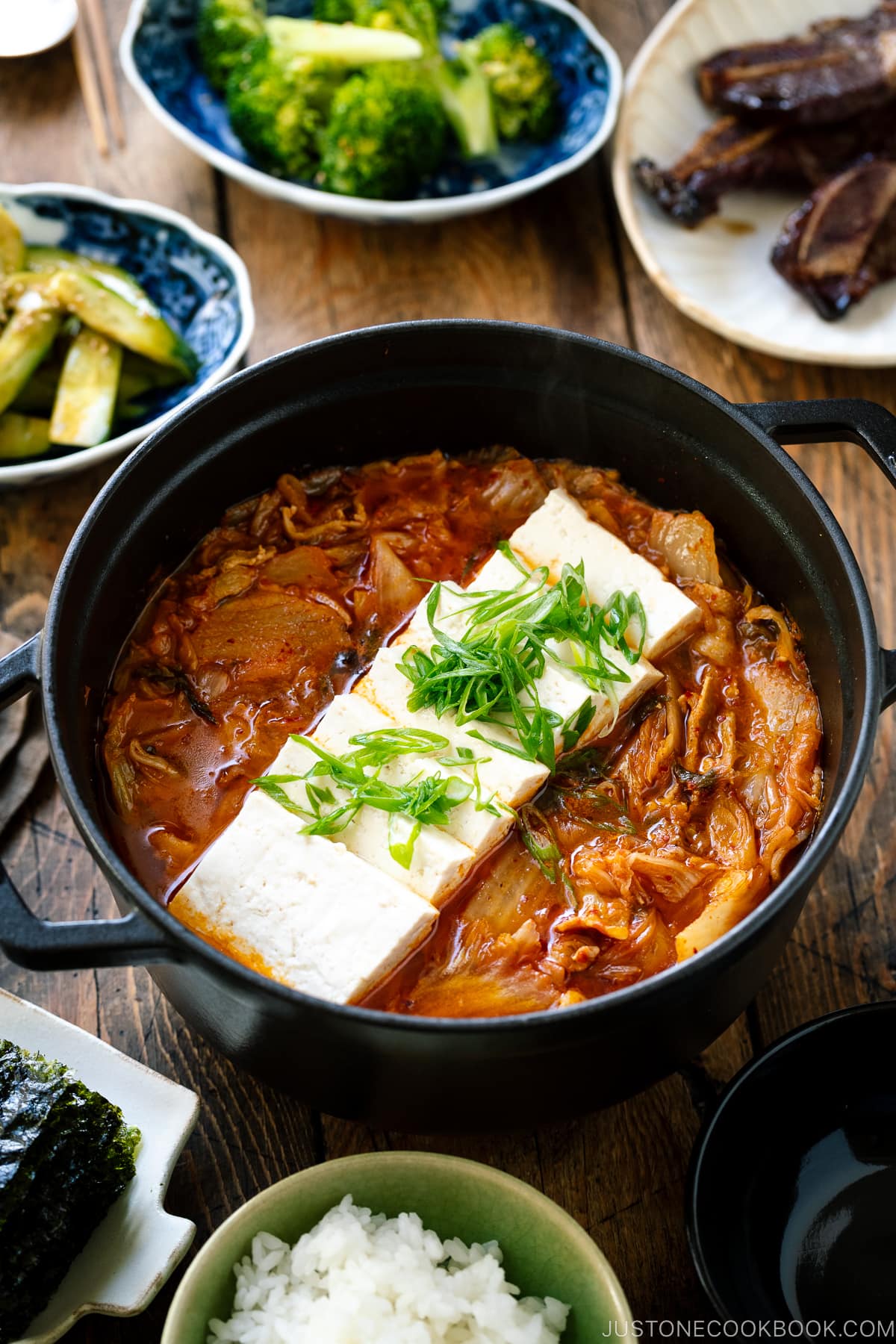
San Francisco can get chilly and cold at night even in the summertime, so we crave for hot soups and stews all year round. One of our favorite recipes I want to share today is Kimchi Jjigae. This Korean stew is very comforting and easy to make. As a busy mom, I often rely on a quick hearty meal like this to feed my family of four as it can never go wrong. I hope it will be your family’s favorite too!
What is Kimchi Jjigae
Kimchi jjigaesometimes written as kimchi chigae, is a classic Korean spicy stew made with napa cabbage kimchi, meat (usually pork belly), and tofu. It’s a robust dish perfect for cold months.
The stew is full of flavor: spicy, sour, salty, savory, and sweet. The old, sour kimchi—traditional Korean fermented napa cabbage—gives a whole dimension of deep flavors to this dish.
Compared to some western stews that take hours to cook, this Korean stew is pretty easy and quick to make. You can put it together with the typical Korean ingredients that are often found in the refrigerator and pantry.
There is a lot of room for variation too; you can add protein (meat and seafood), vegetables, and mushrooms. For today’s recipe, let’s keep it simple; it only takes about half an hour from start to finish.
You may wonder why I’m sharing a Korean dish on this blog where I share mostly Japanese foods. Well, Korean dishes are super popular in Japan, but in general, they are less spicy than the Korean counterpart since the Japanese are not used to spicy foods. I always keep a tub of kimchi in my fridge for serving as a side dish or for making this stew, Kimchi Fried Rice, Pork Kimchi stir-Fry, Tomchi Soupand Kimchi Nabe.
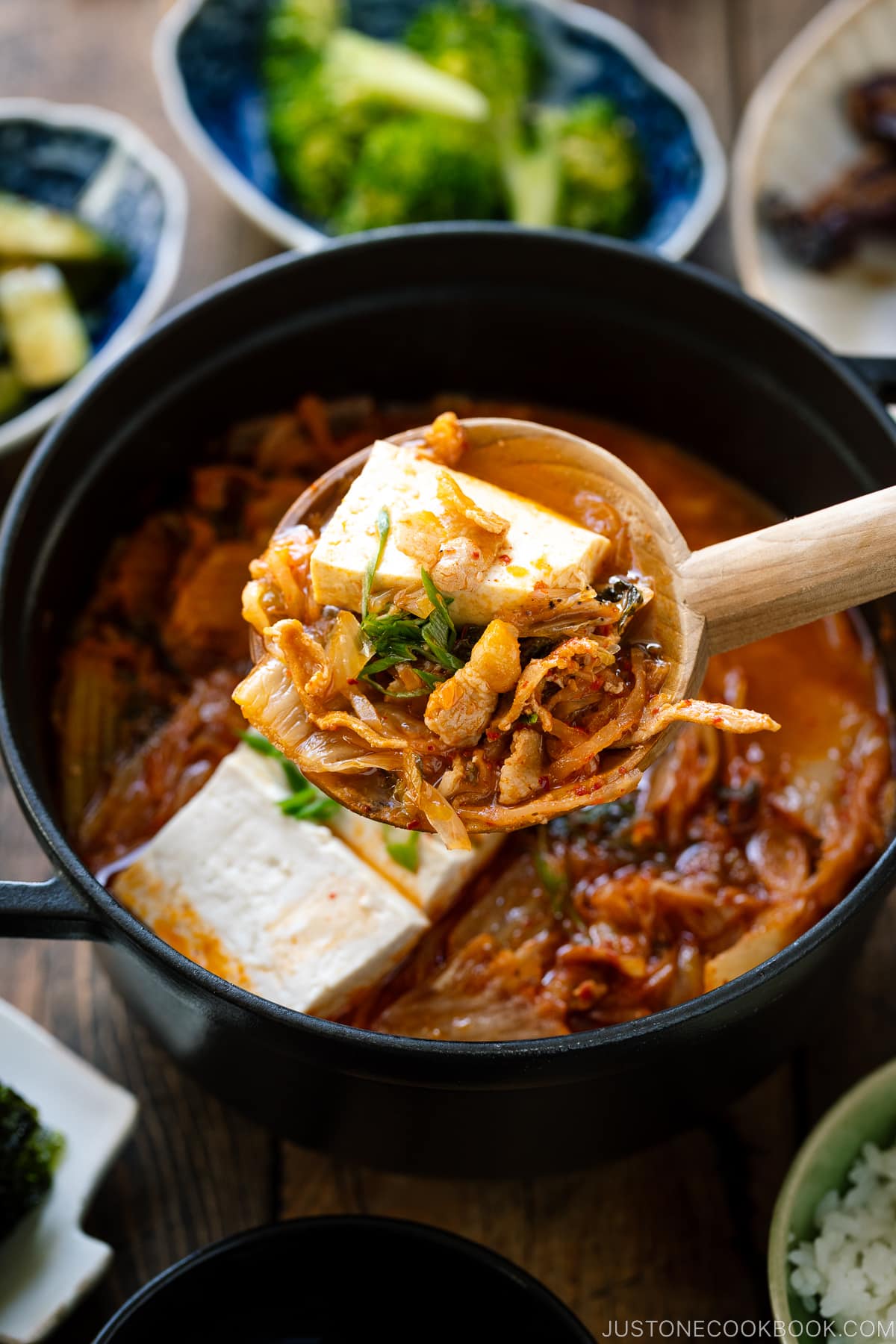
How to Make Kimchi Jjigae
Ingredients You’ll Need
- Napa cabbage kimchi – The well-fermented, old, sour kimchi is the best! Fresh kimchi doesn’t yield much flavor, so it’s not suited for this recipe.
- Anchovy stock – You can use water or other broth, but I like to stick to the authentic flavor as much as possible. Plus, anchovy stock is super easy to make!
- Pork belly slices – You can use other proteins like seafood or other types of meat, but a slab of fatty pork belly is a great choice.
- Tofu – I use medium firm tofu, but soft tofu is okay to use. Just be careful not to break into small pieces when you serve/mix the stew.
- Garlic
- Green onions
- Roasted sesame oil
- Seasonings: sake, soy sauce, sugar, gochujang (Korean chili paste), and gochugaru (Korean pepper flakes) – If you never made Korean food, these ingredients may be unfamiliar. However, the duo are the must-haves for making many Korean dishes. Once you start using them, you’ll discover their versatility and will enjoy using them in spicing up your food.
Overview: Cooking Steps
- Start making the anchovy stock at least 30 minutes prior to cooking. You can also soak the anchovies overnight.
- Prepare the ingredients by cutting the pork belly, tofu, and green onion.
- Stir fry the pork belly until it is no longer pink.
- Add the kimchi and the seasonings. Cook for 15 minutes.
- Add the tofu and cook for 5 minutes. Serve hot!
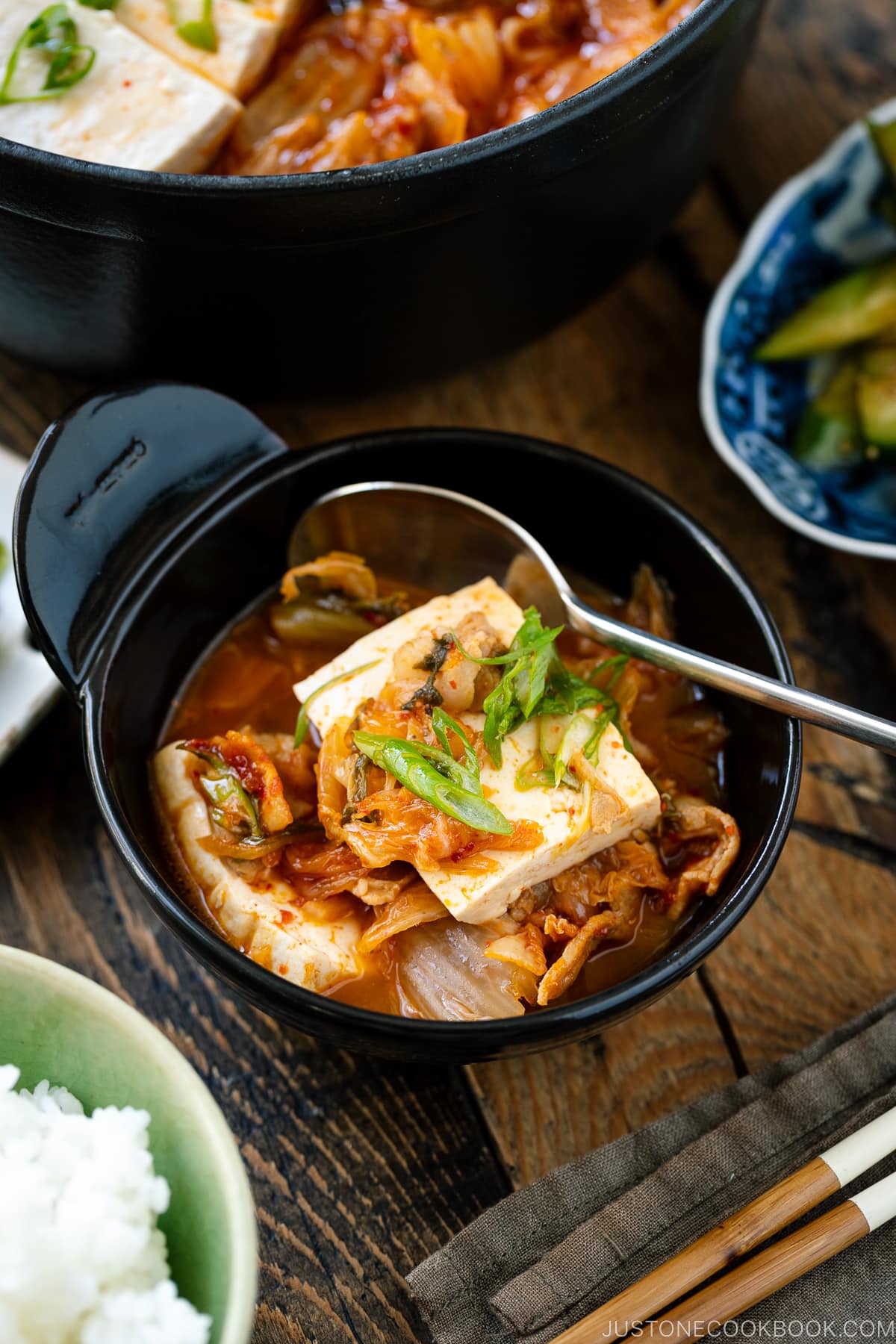
My Favorite Kimchi
Many of you have asked which kimchi brand I like. We like Jongga (宗家) kimchi. It’s supposedly Korea’s number-one brand of kimchi, and it does live up to its reputation.
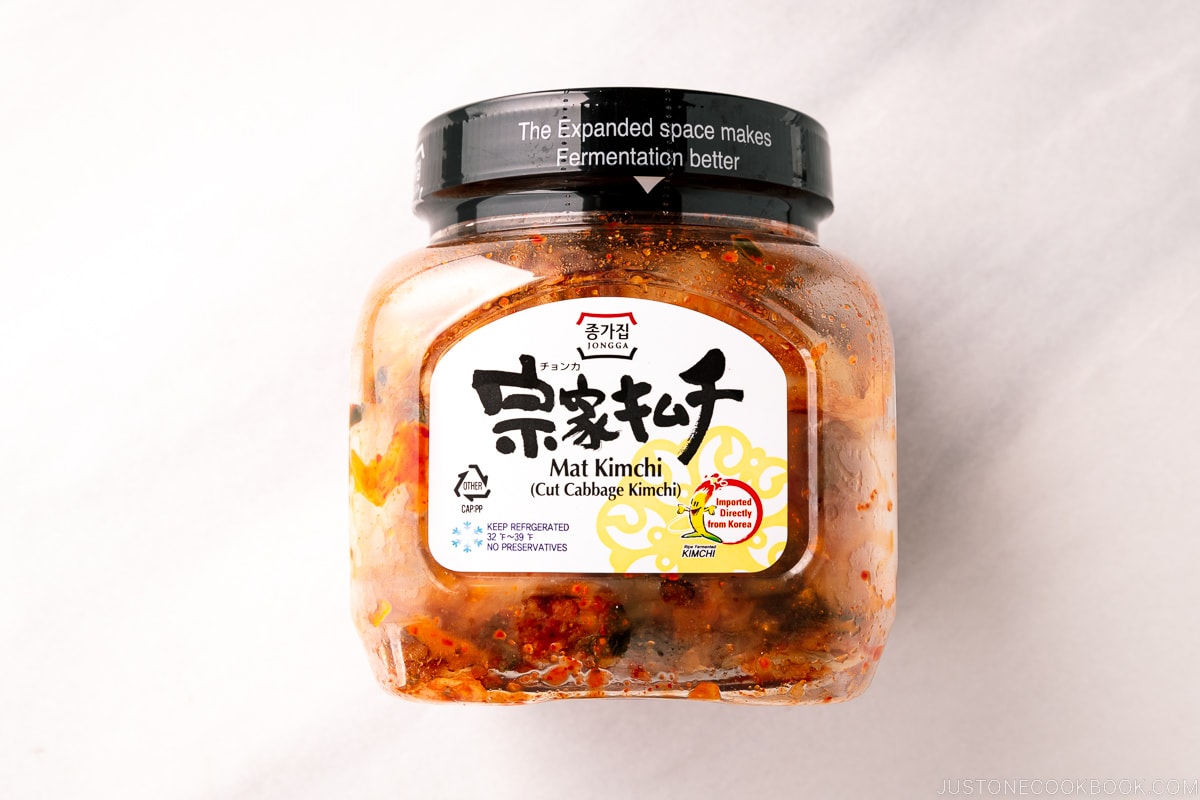
You can get this brand at Korean supermarkets like H Mart and Galleria, but it’s usually sold out at my nearest Korean grocery store (Kukje in San Francisco), so I get the imported Japanese version at a Japanese grocery store.
I’m not sure if this Japanese version from Jongga has a milder taste for the Japanese people or not… but it’s directly imported from Korea.
One day I plan to make it from scratch! I have the Fresh Kimchi recipe but it’s not so suited for making kimchi stew.
Kimchi Jjigae Cooking Tips
- Use well-fermented, sour kimchi. What do you mean by well-fermented? It’s the old kimchi that’s been sitting in the fridge and turning into a sour and complex flavor. Don’t worry, when it’s cooked, that funky smell and taste will turn to deliciousness.
- Freeze the pork belly before cutting. Whenever I cut fatty meat like pork belly, I freeze the meat for 5-10 minutes so it’s super easy to cut into small pieces.
- Add the sake to the pork. Sake helps to remove the pork’s gamey odor; you also can use Chinese rice wine or dry sherry, or otherwise, skip it.
- Add a little bit more sugar if your kimchi is too sour or you’re not used to the taste. Sugar balances out the flavor and reduces the acidic taste.
- Add a little bit of gochugaru and gochujang to the stew to add more heat, color, and deep flavor.
What to Serve with Kimchi Jjigae
Serve the stew bubbling hot in individual bowls. You can serve Kimchi Jjigae with a bowl of hot steamed rice, some meat or fish, and refreshing vegetable sides.
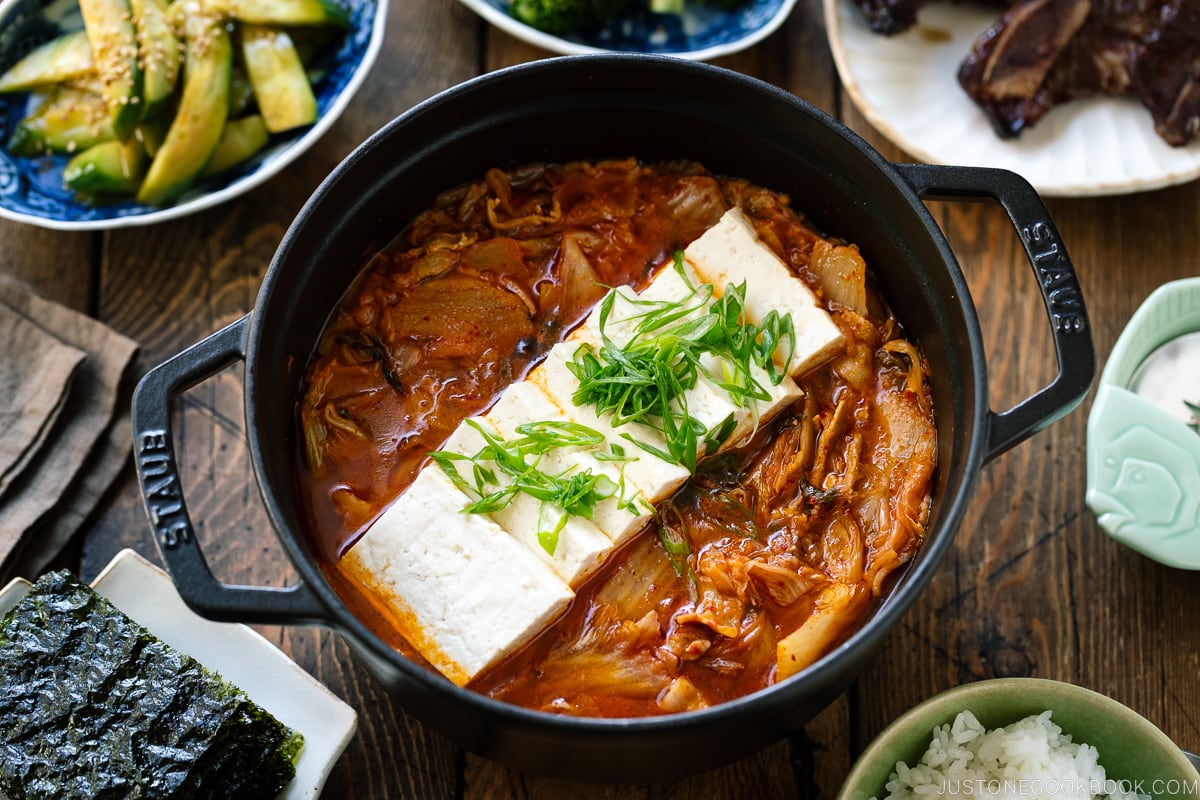
Wish to learn more about Japanese cooking? Sign up for our free newsletter to receive cooking tips & recipe updates! And stay in touch with me on Facebook, Pinterest, YouTubeand Instagram.
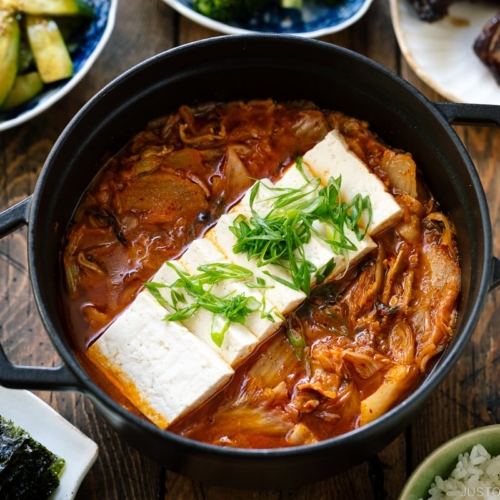
Kimchi Jjigae (Kimchi Stew)
Kimchi Jjigae is a spicy Korean stew of pork belly, tofu, and Korean fermented napa cabbage simmered in a delicate anchovy broth. My simple version is full of sweet, salty, sour, and spicy flavors. Popular in Japan, Kimchi Jjigae will warm you up and keep the chill at bay.
Ingredients
Prevent your screen from going dark
Instructions
Before You Start…
-
Please note that if you have not prepared your anchovy stock ahead of time, it will take at least 30 minutes to make. See my recipe below.
-
Gather all the ingredients.
To Make the Anchovy Stock (if you haven‘t made it yet)
-
I use these big and thick dried anchovies called it is from a Japanese market. Remove the head, belly (the bottom side), and black gut from the fish to reduce the bitter flavor of the stock. Soak ¼ the current cup in 2 cups water for at least 20–30 minutes (or overnight). This cold brew anchovy stock is called iriko dashi in Japanese.
-
Transfer the cold brew iriko dashi and anchovies into a small saucepan and slowly bring it to a boil. Once boiling, reduce the heat to low and cook for 8–10 minutes. Turn off the heat and set it aside.
To Prepare the Ingredients
-
Cut 7 oz medium-firm tofu (momen dofu) in half along the long side and cut into ½-inch (1.3-cm) slices.
-
Thinly slice 2 green onions/scallions diagonally. Separate the white and green parts.
-
Cut 4–6 oz sliced pork belly into pieces 1½ to 2 inches wide.
To Cook the Kimchi Jjigae
-
Set a medium or large pot on medium heat. Once it’s hot, add 1 Tbsp toasted sesame oil and the pork belly.
-
Cook, stirring frequently, for 2–3 minutes, or until no longer pink. Season with ¼ tsp Diamond Crystal kosher salt and ⅛ tsp freshly ground black pepper.
-
Add 1 Tbsp sake and cook, stirring frequently, for 1 minute.
-
Add the white part of the green onions and 1 lb kimchi. If the kimchi is not cut yet, use a pair of scissors to cut it into bite-size pieces.
-
Mince and add 2 cloves garlic (I use a garlic press). Cook, stirring frequently, for 2–3 minutes until the kimchi is tender.
-
Add 1 tsp gochugaru (Korean pepper flakes), 2 tsp gochujang (Korean chili paste), 2 tsp soy sauceand 1 tsp sugar.
-
Stir to mix. Next, add 2 cups Iriko Dashi (anchovy stock) by straining it through a fine-mesh sieve over the pot. Then, add ¼ cup kimchi juiceif there is any (I didn‘t have any).
-
Bring it to a boil, and then lower the heat to a simmer. Continue to cook for 10 minutes.
-
Add the tofu slices on top and cook until the tofu is heated through, about 5 minutes. You can submerge the tofu, but I left it on top to keep the tofu‘s white color for the final presentation.
-
Garnish with green onions and keep it covered until ready to serve.
To Serve
-
Serve bubbling hot in individual bowls. You can serve Kimchi Jjigae with a bowl of hot steamed rice and some meat or fish (such as Bulgogi or Grilled Mackerel).
To Store
-
You can keep the leftovers in an airtight container and keep them for 3 days in the refrigerator or for up to a month in the freezer. When you freeze it, remove the tofu as its texture will change when frozen. You can add fresh tofu when reheating the stew in a pot on the stovetop over medium heat.
Nutrition
Nutrition Facts
Kimchi Jjigae (Kimchi Stew)
Amount per Serving
% Daily Value*
* Percent Daily Values are based on a 2000 calorie diet.
©JustOneCookbook.com Content and photographs are copyright protected. Sharing of this recipe is both encouraged and appreciated. Copying and/or pasting full recipes to any website or social media is strictly prohibited. Please view my photo use policy here.
Editor’s Note: This post was originally published on September 9, 2013. The post has been republished with the revised recipe, updated images, and blog content on January 9, 2023.

